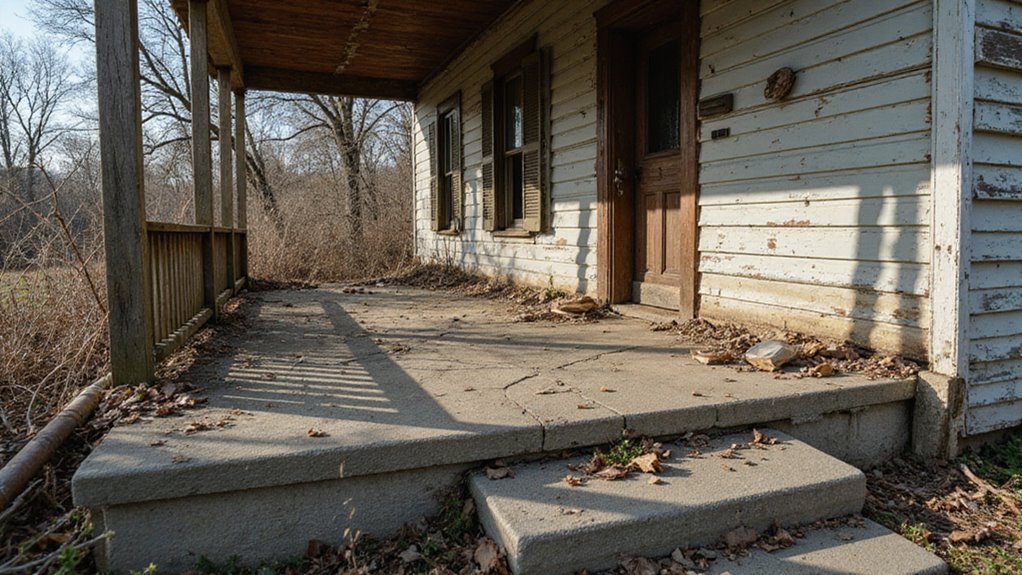What Does As Is Mean in Real Estate?
Walking into your dream home, only to discover hidden structural issues months later—a nightmare scenario when buying “as is” properties. Most buyers face significant financial strain when unexpected repairs emerge after purchasing homes in their current condition. Without proper knowledge, these transactions can lead to regret and legal complications. Understanding “as is” sales properly helps protect your investment and provides peace of mind.
“As is” in real estate means the buyer accepts the property in its current state without requiring the seller to make repairs or provide credits. The seller has no obligation to fix any issues discovered before or after the sale is completed. This arrangement typically results in lower purchase prices but transfers all responsibility for existing problems to the buyer.
In this blog I will explore everything about “as is” property sales and how to navigate them safely.
Key Takeaways
- “As is” means the property is sold in its current condition, with no repairs or improvements made by the seller.
- Buyers accept all defects and risks, often after conducting inspections and reviewing disclosures.
- Sellers are not obligated to fix issues or provide credits; the sale typically involves fewer repairs and faster closing.
- The property must be clearly labeled “as is,” and known defects must be disclosed per legal requirements.
- “As is” sales benefit sellers through reduced repair costs and benefit buyers through potential lower prices, but involve higher risk.
What Does “As Is” Mean in Real Estate?

In real estate, “as is” means the buyer accepts the property in its current condition without repairs. The seller won’t fix issues or provide credits after closing.
Sellers must still legally disclose any known defects that affect the property’s value or desirability.
Property disclosures deserve your close attention when purchasing an “as is” home. This type of sale transfers all responsibility for future repairs to the buyer.
Furthermore, you should conduct thorough inspections before finalizing the purchase.
Most importantly, “as is” sales protect sellers from post-closing repair demands while giving buyers potentially lower prices.
How Do “As Is” Home Sales Work?

You need to understand how “as is” home sales proceed, starting with listing the property clearly in the MLS and marketing materials.
Buyers should perform thorough inspections and include contingencies in their offers to protect their interests.
Additionally, sellers are required to disclose known defects, even though repairs aren’t mandated, making legal documentation and transparency critical to the process.
Understanding the Basic Process
An “as is” home sale requires buyers to accept the property with all existing defects. The seller has no obligation to make repairs after the sale completes. Property condition disclosures reveal known issues, but buyers assume all risks.
Inspections remain important during these transactions. Buyers can still conduct inspections to identify potential problems with the property. The inspection period allows for a thorough assessment.
However, unlike standard sales, sellers can refuse repair requests without consequences. This arrangement benefits sellers who can’t afford repairs or need a quick sale.
For buyers, “as is” properties often come at lower prices to offset potential repair costs. The tradeoff requires careful consideration of potential expenses.
Legal Documentation Requirements
Texas law requires specific documents for “as is” home sales. The TREC contract with Paragraph 7D clearly establishes the property’s as-is status.
You must provide a complete Seller’s Disclosure Notice to buyers. This document reveals all known defects and property conditions.
Clear title documentation protects both parties in the transaction. Title research identifies any liens, easements, or legal issues affecting the property.
Understanding disclosure requirements helps prevent future liability claims.
Additionally, proper documentation creates transparency throughout the selling process. Most legal disputes arise from inadequate or misleading disclosures about property conditions.
Disclosure Obligations in “As Is” Sales
Sellers must disclose known property defects in “as is” sales. This legal requirement applies to all defects affecting value or safety, regardless of sale terms. Failure to disclose creates liability under most state laws.
Structural issues, mold, pest problems, and mechanical failures require full disclosure. These obligations protect buyers from hidden dangers and sellers from future lawsuits.
Furthermore, proper disclosure builds trust in the transaction. Many states have specific disclosure forms that must be completed accurately.
Even verbal admissions about property problems can be legally binding in court.
What Problems Can “As Is” Properties Have?

“As is” properties often have hidden issues like structural problems, outdated systems, or mechanical failures that can lead to costly repairs.
You might also face legal or title complications, such as liens or boundary disputes, that complicate ownership.
Additionally, environmental hazards like mold, lead paint, or pests can pose serious health risks if not identified early.
Structural Issues
“As is” properties often have hidden structural problems that cost thousands to repair. Look for foundation cracks, roof damage, faulty systems, and pest infestations before buying.
Foundation issues can destabilize the entire house and typically cost $4,000-$10,000 to fix.
Roof problems may cause extensive water damage throughout the home. Meanwhile, outdated electrical wiring creates fire hazards in older properties.
Professional inspections reveal these hidden defects. For this reason, always hire qualified inspectors to examine any “as is” property thoroughly. Their findings could save you from expensive surprises later.
System and Mechanical Failures
“As is” properties often have hidden system and mechanical problems that cost money and create dangers. These issues range from old HVAC systems to faulty wiring and plumbing problems. A complete property inspection helps find these issues before purchase.
Hidden problems like roof damage affect both safety and finances. For example, outdated HVAC systems can increase energy bills by 50-100%.
Similarly, faulty electrical systems pose fire hazards in approximately 25,000 homes annually. Water damage from plumbing issues may require repairs costing thousands of dollars.
Most importantly, addressing these problems early prevents larger expenses later.
Legal and Title Problems
“As is” properties often come with legal and title risks that affect ownership rights. You should check for unresolved liens, boundary issues, code violations, and hidden title defects before purchasing.
Outstanding liens can force you to pay previous owners’ debts. These might include tax liens, contractor liens, or judgment liens. Boundary disputes create costly headaches when property lines differ from records.
A real estate attorney can help identify these problems early. They’ll review title reports, perform legal searches, and suggest solutions. Additionally, title insurance protects against unforeseen claims that might emerge later.
Environmental Concerns
Environmental hazards in “as is” properties create significant health and financial risks. Many dangerous conditions remain hidden during standard inspections. Mold, lead paint, asbestos, contaminated soil, and underground tanks often require expensive remediation.
Smart buyers always conduct specialized environmental assessments before purchase. Federal and state laws may hold property owners responsible for cleanup costs regardless of when contamination occurred.
Furthermore, environmental issues can decrease property value substantially. Despite seller disclosures, the ultimate responsibility falls on buyers to investigate thoroughly. In other words, proper due diligence protects your investment and your family’s health.
What Are the Risks for Buyers of “As Is” Properties?
Buying “as is” properties comes with significant financial and legal risks. You accept all defects without seller repairs or credits.
Unexpected repair costs can quickly drain your budget after purchase. Most lenders hesitate to finance properties in poor condition. Your options become limited if you discover problems after closing.
Hidden issues like foundation damage or mold might remain undetected until you own the property.
Therefore, always conduct thorough inspections. At the very least, hire qualified professionals to assess the structure, electrical systems, and plumbing. Additionally, consider setting aside extra funds for inevitable repairs.
What Are the Benefits for Sellers Going “As Is”?
Selling “as is” helps you avoid costly repairs and reduces your upfront expenses.
It speeds up the sales process and minimizes negotiations, making transactions more straightforward.
Plus, it attracts cash buyers and investors eager to take on properties needing work, increasing your chances of a quick sale.
Reduced Repair Costs
Selling “as is” saves you money on pre-sale repairs and renovations. You avoid spending on fixing structural issues, cosmetic updates, or system replacements.
Homeowners typically save $5,000-$25,000 by skipping repairs before selling. This approach eliminates contractor costs and material expenses.
Your property sells faster because you bypass the repair timeline completely.
Additionally, you won’t need home warranties or service guarantees. Cash buyers and investors often prefer these properties precisely because they’re unimproved.
In fact, many investors specifically look for homes they can renovate themselves.
Faster Sales Process
“As is” property sales complete much faster than traditional sales. You skip time-consuming repairs and lengthy negotiation phases that typically delay closings. This approach appeals strongly to investors and cash buyers looking for immediate opportunities.
The timeline shortens dramatically because inspection contingencies and repair requests disappear from the equation. Most “as is” transactions close in half the time of conventional sales. Buyers know exactly what they’re getting.
Additionally, paperwork simplifies when you remove repair agreements and contingency forms. The streamlined process benefits both you and your buyer through reduced closing costs and administrative steps.
Less Negotiation Complications
“As-is” listings simplify the negotiation process significantly.
You’ll face fewer repair demands from buyers after inspections. Property transparency establishes clear expectations upfront, preventing surprises later. The price discussions become more focused when buyers understand they’re purchasing with existing conditions.
For many sellers, this approach eliminates the typical inspection-repair negotiation cycle.
Closing timelines can shorten by 7-14 days without repair negotiations. Most importantly, both parties understand the terms clearly from the beginning. As a result, the entire transaction flows more smoothly.
In essence, an “as-is” sale creates a straightforward path to closing with minimal back-and-forth.
Appeal to Cash Buyers and Investors
Cash buyers and investors seek “as is” properties for distressed property opportunities. They want deals without repair requirements. Sellers benefit from quicker closings and fewer contingencies with these buyers. The process attracts those seeking hassle-free transactions.
Cash transactions often close in days rather than weeks. Most investor purchases complete within 1-2 weeks versus 30-45 days for traditional sales. Furthermore, these buyers typically waive inspections and appraisals. This approach works especially well for inherited properties or financial hardships.
As a result, targeting cash buyers creates a more predictable selling experience. You’ll face less negotiation over property condition issues. In addition, you can avoid costly staging and preparation expenses.
How to Protect Yourself When Buying “As Is” Properties?
To protect yourself when buying an “as is” property, start with a thorough home inspection to uncover hidden issues.
Review the title carefully to identify any liens or legal problems, and include contingency clauses in your contract for inspections, financing, and title review.
Finally, obtain repair estimates and consult a legal professional to ensure your rights are safeguarded before finalizing the deal.
Thorough Home Inspection
“As is” properties require thorough inspections to reveal hidden defects. Qualified professionals can identify issues in electrical systems, foundations, and roofing before you finalize your purchase.
Hire a licensed inspector with experience examining distressed or older properties. They’ll check structural integrity, mechanical systems, and potential pest damage comprehensively.
The inspection report serves as your protection against unexpected expenses.
After receiving the report, you can make informed decisions. Many buyers use inspection findings to negotiate price reductions or request critical repairs. This strategy helps balance the risks associated with “as is” purchases.
Title Research
Title research reveals crucial information about a property’s legal status before you buy. You need to check for liens, ownership disputes, and encumbrances that could affect your rights. Public records contain most ownership information, but professionals can help ensure accuracy.
A title company or attorney will conduct a thorough search for potential problems. Local laws may require specific documentation to complete a valid property transfer.
Title insurance provides additional protection against hidden defects discovered after purchase. This coverage safeguards your investment from unexpected claims.
Consider this essential protection when buying “as is” properties with potential complications.
Contingency Clauses
Contingency clauses protect buyers when purchasing “as is” properties. They allow you to withdraw from the deal under specific conditions without penalty.
You can inspect the property within an agreed timeframe to find potential defects. These inspections reveal hidden problems the seller may not disclose.
You maintain the right to request repairs based on inspection results. Financial protection is another key benefit.
Financing contingencies ensure you can back out if lenders reject your loan application due to property condition. Additionally, title contingencies let you review all legal documents before finalizing.
Without these safeguards, buyers face significant financial risks when purchasing problematic properties.
Getting Repair Estimates
To avoid unexpected expenses on “as is” properties, hire licensed contractors or inspectors. These professionals provide accurate repair assessments during your home inspection.
Inspection costs typically range from $300-$800. Use these estimates to evaluate potential expenses and negotiate with sellers.
Additionally, the figures help you determine if you’re comfortable with future financial commitments. An inspection contingency protects your interests if major issues arise.
In most cases, detailed estimates prevent budget surprises and strengthen your negotiating position.
Legal Review of Documents
A thorough legal review protects you when buying “as is” properties. Always check the purchase agreement carefully.
Section 11 must guarantee the property’s condition at closing.
Section 14B contains important inspection deadlines you must follow.
Sellers have legal obligations under disclosure laws despite “as is” status. An attorney can explain these responsibilities clearly.
Different states have varying requirements for “as is” sales.
Therefore, professional legal guidance prevents costly disputes later.
Furthermore, understanding your rights gives you negotiating power if issues arise during the process.
What’s the Difference Between “As Is” and Traditional Sales?
“As is” sales mean buyers accept properties in their current condition without repairs. These properties typically sell at lower prices with minimal seller obligations.
Traditional sales allow buyers to request repairs and negotiate improvements before closing.
Buyers gain more protection in traditional sales through inspection contingencies. Most traditional sales include warranties and disclosures about property conditions.
The transaction timeline often moves faster with “as is” sales. For sellers, “as is” sales reduce pre-sale preparation and post-inspection negotiations.
However, traditional sales usually fetch higher prices despite additional work required.
Ready to Sell Your Home “As Is”? Contact Next Step House Buyers Today
You can sell your home “as is” through Next Step House Buyers. We purchase properties in their current condition without requiring repairs.
Our team handles all paperwork and legal requirements for you. You’ll save thousands by avoiding repair costs, inspection fees, and real estate commissions.
The process is straightforward and quick. First, we evaluate your property. Then, we make a fair cash offer based on its current state.
Many sellers appreciate our no-obligation approach. Furthermore, we can close on your timeline, whether that’s days or months.
Frequently Asked Questions
What Does “As Is” Mean in Real Estate?
In real estate, “as is” means you accept the property’s present condition, with no seller repairs promised. You’re responsible for uncovering and understanding issues, making informed decisions with disclosures, inspections, and legal safeguards to protect your interests.
What Are the Risks of Buying as Is?
Buying as-is puts all repair risks on you, including hidden defects and costly surprises. You might face financing issues, legal disputes, or significant renovation costs, so conduct thorough inspections and research before committing to protect your investment.
Can You Get a Mortgage on as Is?
Mortgage possibilities depend on property condition; conventional lenders demand minimum standards, while FHA offers flexibility. Consider renovation financing, like FHA 203(k), and always have a thorough inspection, ensuring your financing firm follows facts, not fears.
Why Would a House Be Sold as Is?
You may sell a house as-is to save on repair costs, speed up the sale process, attract investors, or address urgent situations like financial hardship or distressed properties, enabling a quicker transaction without the burden of fixing issues beforehand.
